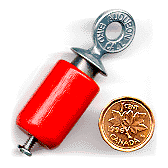Birding in British Columbia
A hub for birding information for British Columbia, Canada. Featuring Rare Bird Alerts, directory to nature clubs and online birding groups, birding forums, and more.
Every birder knows that sometimes our little friends just don't want be seen. No matter how still and quiet we remain, they happily continue their chirps and squeaks hidden deep in the bushes or high up in the canopy. This can be very frustrating as we try to catch a glimpse at whatever the heck is in there. Finally we tire waiting patiently and as the saying goes, "If you can't beat them, join them."
Pishing, Sucking, and Squeaking: Calling Birds
By K. Slagboom
Making noises to attract a bird--it's kind of a private thing. At least most of us don't do it when there are other people around except maybe to demonstrate to someone. (This can be a good excuse to making those silly sounds while in public.) The truth is, those silly noises do work ...some of the time.
Ethics of Actively Calling BirdsBefore diving deep into how to call birds, let's discuss the impact we have in actively doing so. There is debate over whether is it ethical to attract or distract birds when they should be busy looking for food, defending territory or raising young. Generally, most birders don't call birds but on occasion when they do, they keep pishing and other forms of calling birds to a minimum so as not to disturb the birds for a prolonged period and calling birds during nesting season is generally frowned upon. Birding is a passive activity where patience is often rewarded. Sometimes a bird in the bush may need a single pish or a call to "nudge" it into the open for have a look but use your best judgment when choosing to call out a bird. The TheoryThe theory goes, if you make a call sound and repeat it several times dramatically, you simulate mobbing activity by a small flock of birds and you may attract a curious bird. This can be observed by watching a bird sound the alarm when a threat, like a cat, is near. In turn, the initial alarm attracts others to raise awareness of the danger. This goes on until the danger has passed. Now, when a birder makes a noise that sounds like a bird nearing imminent doom, the closest birds rush in agitated (again, be mindful of the ethics here) by the commotion. Further off birds hear you and the closer birds making a racket so that come in to join the party. Next thing you know, a whole group of mixed species is chirping around you and you can't decide which one to look at first. That what can happen when it works. However, pishing and bird calls can also scare off as well as quiet all the birds around you and you then feel pretty stupid standing there all by yourself with nothing to look at. At any rate, it's worth a try when things are slow or that one elusive bird refuses to pop up to be seen. |
Types of CallsPishing: A drawn out "Psssshhhhhh" or short rapid "Pish pish pish pish" that is repeated. Variations can be made in speed and pitch but consistent repetition is the key. Sucking: Simply kiss the back of your hand. The object is to make a loud (or quiet) quick sucking noise. Again, use a consistent pattern of repetition. Calling: Some of us have the talent to mimic a bird's call or song by whistling, and throat-calling. You can quite possibly talk to a Raven this way. Gadgets: The "Audubon Bird Call" or "Squeaker Device" is a nifty little Birchwood -metal instrument that when twisted produces varying squeaking sounds.
For Ducks, try a standard duck call. (Watch out for the duck hunters though!) Recordings: With smart phones, you can play bird songs and calls at a button press. These do work well for calling in all kinds of birds, sometimes too good. Please do not over do it as it will disturb the birds. Hawks and Owl calls can excite the passerines around so introducing a virtual predator into the area and have a disruptive effect on resting or feeding behaviour. |
Some Tips to Calling in Birds:
Stand beside some bushes or under a low tree and remain absolutely still and make a quiet call. Sometimes birds will come right up to you to investigate so provide them somewhere to land.
Louder in not always better. Sometimes a short, subtle call will do the trick.
Patience will pay off. After a calling a bird, wait for several minutes to see if something interesting shows up. Look and listen as birds that came in to investigate might be still be quietly moving through the bush.
Experiment. There isn't any stead-fast rules to pattern and rhythm. What works for one area might not work for another.
Here on the West Coast, you can be sure to attract at least one of these species: Black-capped Chickadee, Chestnut-backed Chickadee, Bushtit, Spotted Towhee, Dark-eyed Junco, Bewick's Wren, Ruby-crowned Kinglet, Golden-Crowned Kinglet, Song Sparrow, Fox Sparrow, Golden-crowned Sparrow, White-Crowned Sparrow.
Finally, don't be surprised when you call in something that doesn't fly. That prowling cat enjoys your bird calls as much as the birds.
Enjoy your bird calling!
For more information on calling birds:
http://www.bsc-eoc.org/download/BWCfa05.pdf
Birding in British Columbia is a BC Birding resource and community message board maintained by Kevin Slagboom | About
